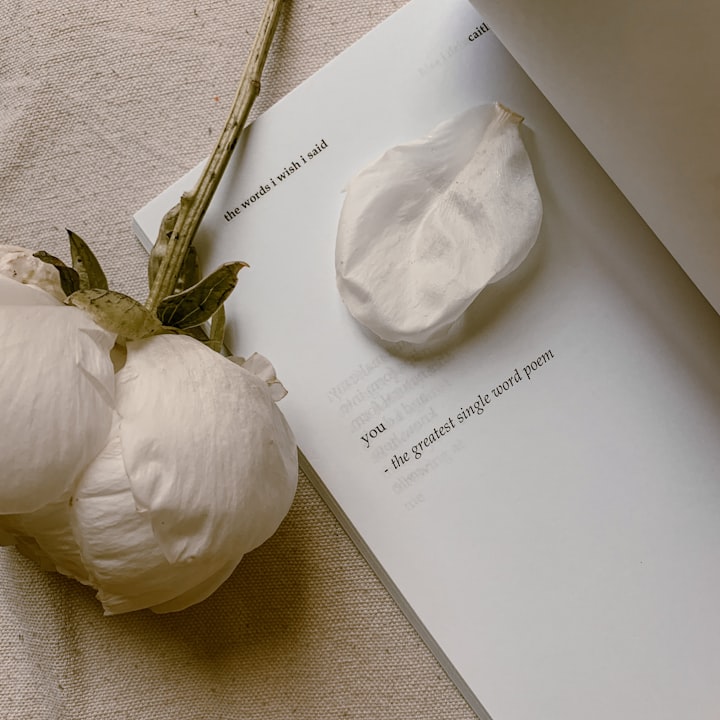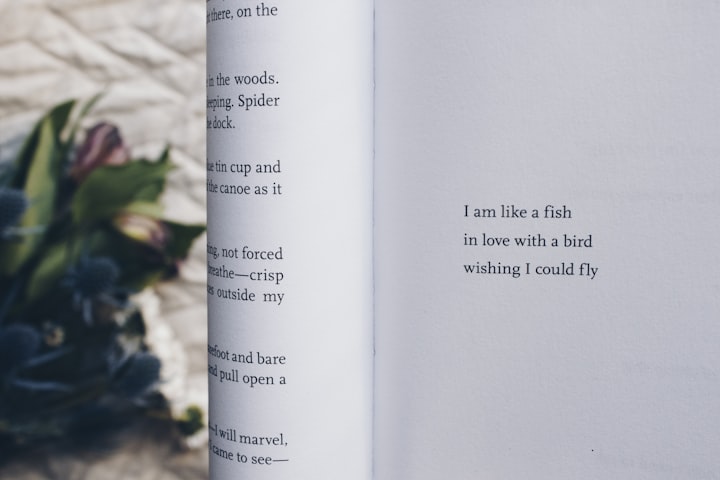How To Analyze A Haiku
Literary Devices Abound in Vocal’s Vault
The question kept coming up, Why does Vocal keep putting out haiku challenges? Three writers on Vocal of note certainly queried recently: sleepy drafts in “Why Haiku?”, MikeyDred in “Plague of Haiku”, and Scott Wade in “The Anarchy of a Haiku Challenge” (article links below).
Add to this the list of recent poetry- and haiku-based challenges, and we see where they are coming from:
- High-ku (November 10-16)
- Blue Haiku (December 4-16)
- Full Moon (December 20-January 5)
- Quadra-haiku (January 10-24)
- Uncommon (January 24-February 9)
- Time Capsule (February 9-February 28)
The Benefit of All These Haiku and Poetry Challenges
All these haiku and poetry challenges mean a hoard of material (I mean “art”) I can use to help you understand how to analyze poetry. There is literally a whole vault of literary and poetic devices on Vocal. I get to use modern poems to show these terms in action. This means a fresh, contemporary poem by an artist you can support, follow and interact with now!
Haiku Infatuation
The Vocal Curation Team initially stated their reason for haiku-love in “Blue Haiku Challenge Winners”:
We love haiku Challenges. Not just because poems are shorter and it's easier to give each work its proper due, though it's always a joy when we get to spend more time with each piece of writing. No, we love haiku Challenges because they push writers to their creative limits. How much can be said in so few words? How deep can one go, quickly?”
What’s more, Vocal even personally responded in article form to the questions and despair posed by so many writers over haikus in “So, How Do We Count Syllables?” This one was addressed specifically to Harmony Kent’s question raised in “Dear Vocal Judges/Fellow Poets…: A question on syllable counting” (article links below).
Vocal Claps Back
Whether a twist of wit or not, Vocal clapped back with another poetry challenge! But instead of a haiku, we were free to choose the format and length. Up for grabs was the recent Uncommon Challenge. Its requirements were much like the recent Full Moon Challenge where all forms of poetry were accepted, and there was no minimum word count (you just couldn’t exceed 2,000 words).
And now Vocal presents another haiku challenge ripe for the picking. The focus? Time. Right as the Uncommon Challenge ended (February 9th), Vocal immediately opened the Time Capsule Haiku Challenge (February 9th). Want to enter? See the link below.
Haiku In Modern Times
Time to get back to what the venerable form of haiku has to offer us currently.
I just started a series on how to analyze poetry. The first article focused on the basics needed to start the process of a deep dive into a poem. We covered the definition of poetry and annotations, how to count and mark stanzas and line numbers, and mark and determine rhyme scheme.
Now we are going to review what we’ve learned while building onto our base. I chose haiku for learning about annotations and literary devices because they are succinct, which most students would easily challenge as being way too difficult to find enough to annotate to write a whole essay.
I am here to prove that even the shortest poem can be a treasure trove for a full length essay. To up the ante, I’m going to use the process with two different haiku in this article.
A Review Of Stanzas, Line Numbers And Rhyme Scheme
It is time to apply what we learned from the first article. We are going to determine the stanzas, line numbers and rhyme scheme of real live haiku.
Since the traditional haiku is made up of only three lines, all of the examples here will have the same answer for number of stanzas, line numbers and rhyme scheme.

- Number of stanzas = 1
- Number of lines = 3
- Rhyme scheme = ABC
Annotations for Literary and Poetic Devices
Let us move on to something new. We will now learn about a different set of annotations. Since we already marked the haiku for stanzas, line numbers and rhyme scheme, next we will make our annotations for things we find interesting or of note. In this case, we are going to start learning about Literary Devices. Sometimes they are referred to as Poetic Devices.
Definition Of A Literary/Poetic Device
A literary/poetic device is a word, element, style, or format used to create a rhythm, heighten meaning and/or create a mood. While almost all literary devices can be found and used in poetry, not all poetic devices can be found and used in a piece of literature.

The Literary/Poetic Device of Imagery
For the haiku “All We Are”, there are many literary devices I could focus on. These include: personification, paradox, point-of-view, and oxymoron. But since we are just getting started, I only chose one device to focus on. I annotated the poem by highlighting (circling) all the words I found that deal with nature. The name for the device used is Imagery.
Imagery uses vivid words to paint a picture in the reader’s mind. In this haiku, the words “soil”, “stardust” and “ashes” all create a sense or image of nature for the reader.
If I were to turn this into a paper, I could have a five-paragraph essay by doing the following:
- Paragraph 1: Introduction (Importance of Nature Imagery in “All We Are”)
- Paragraph 2: Body Paragraph 1 (Focus on Soil)
- Paragraph 3: Body Paragraph 2 (Focus on Stardust)
- Paragraph 4: Body Paragraph 3 (Focus on Ashes)
- Paragraph 5: Conclusion (This haiku’s nature imagery is awesome)
Tada! Told you so. An impressive feat, I know. But this is where students still find a reason to protest and say, “Okay, but what kinds of sentences am I going to write?” That will be covered in the next article. The point here is to show that even with three lines of poetry and only 17 syllables, a five-paragraph essay is easily possible.
Time For Another Example!
For these, I’m skipping past identifying and annotating the stanzas, line numbers and rhyme scheme since it is the same for all of them. Plus, the focus of this article is annotating for literary and poetic devices.
The only rule for annotating a poem is to create a key or legend for yourself and anyone, like your teacher, who might ask for it or view it.

In “Heart & Mind: Master & Rider” by Thavien Yliaster, there are many literary and devices I could focus on. Some of these include tone, connotation, denotation, anthropomorphism, contrast, and oxymoron. For the sake of this example, I only annotated for denotation, anthropomorphism, mood and imagery (nature).
The Literary/Poetic Devices of Mood, Anthropomorphism, and Denotation
We already covered imagery in the example above, so I will not cover that here. The annotations I made after Imagery, were for Mood, Anthropomorphism and Denotation. Some of these devices actually overlap, but I only chose to mark each word once. I found that this poem packed a lot of punch by the author stacking devices.
Mood is created by the words chosen by the writer to bring out an emotional response in the reader. In this case, not only are the words in rectangles part of the mood, but also the circled words. All of these words are very strong and suggestive.
Anthropomorphism is when a writer gives human attributes (thinking, talking, blinking, arms, legs, walking, dancing) to an inanimate object or non-human entity (think Alice in Wonderland).
Denotation is the literal dictionary definition of a word. I highlighted the words “stir” and “ground” because while they have a main definition, but the author could be playing with double or triple definitions. For example, does the author want us to think about “stir” as in mixing or “stir” as in brewing up trouble? Then there is the question of is this a double entendre, as Thavien Yliaster is known to have some risqué writings.
Did You Miss The First Article In This Series?
What We Learned Today
Once again, we covered a lot! We reviewed stanzas, line numbers and rhyme scheme. And today we added new ways to annotate a poem. I used a combination of objects like circles, rectangles and stars to note interesting finds in the poems. Usually by the time I’m done annotating a poem it looks like a box of Lucky Charms threw up on the page. That’s why having a Key or Legend is helpful.
We also learned the definition and use of four specific literary/poetic devices: Imagery, Mood, Anthropomorphism and Denotation. Our annotations help us see patterns in poems. These patterns, or lack thereof, help us have the information and examples needed to write a whole essay.
Most of all, we learned that Vocal puts out A LOT of poetry-based challenges. So, there are many opportunities to make some money!
About the Author
Stephanie Bradberry is first and foremost an educator and life-long learner. Her time in academia spans 19 years and counting as a professor of English, Literature, Business and Education, former high school English teacher, and more. She loves freelance writing and editing. She is the founder/owner of Stephanie J. Bradberry LLC and former founder/owner of Crosby Educational Consulting, LLC. Learn more at stephaniebradberry.com
Read The Original Poems Here:
Permissions: The author received the consent and blessing of Michelle Truman and Thavien Yliaster to use their haiku. These are modern poems published by writers on Vocal. That means poems recently published by artists you can support, follow and interact with now!
Read The Articles Referenced Here
https://vocal.media/motivation/why-haiku
https://vocal.media/fiction/a-plague-of-haiku
https://vocal.media/motivation/the-anarchy-of-a-haiku-challenge
https://vocal.media/resources/so-how-do-we-count-syllables
About the Creator
Stephanie J. Bradberry
I have a passion for literature and anime. And I love everything involving academia, health, metaphysics and entrepreneurship.
For products and services, visit: stephaniebradberry.com
For online courses, visit: bradberryacademy.com
Reader insights
Outstanding
Excellent work. Looking forward to reading more!
Top insights
Expert insights and opinions
Arguments were carefully researched and presented
Easy to read and follow
Well-structured & engaging content
Masterful proofreading
Zero grammar & spelling mistakes
On-point and relevant
Writing reflected the title & theme








Comments (36)
https://vocal.media/education/top-10-goals-of-clinical-psychology
Thank you❤️
Very good
https://vocal.media/education/top-10-goals-of-clinical-psychology
Excellent
Thank you for this wonderful article! A valuable addition to the conversation surrounding haiku challenges. Well done! :)
Great job again
I love how you breaks things scientifically to help us understand the deeper root of what we write. Thank you!!!
I don't know why I never saw this one. As usual very well written and a lot of excellent information.
A very detailed breakdown of Haiku, great work 👍.
Very Informative
Good article
Should plastic be banned? :- https://vocal.media/education/should-plastic-be-banned-l11mxp0yxi
https://vocal.media/education/the-ultimate-keto-meal-plan-7mruip0r8g
Interesting breakdown of the form...and I have some work to do... ;)
in short,spectacular. congratulations
Absolutely mind blowing! Really, I got a short way through and my head exploded. Once I have scraped up the goo and put it back in amongst the sawdust I will try reading the rest. Really informative and thought provoking, many thanks for sharing.
Another brilliant article, Stephanie!! Thanks so much for teaching me something new…. again! Looking forward to the next one. :)
Thanks for the info stephanie I find it helpfu
Congratulations on being Top Story! And thank you for referencing and linking to my post on ‘Dear Vocal Judges/Fellow Poets’. Much appreciated. These are wonderfully informative articles on poetry 💕🙂
I was told that in haiku, no capitalization and no punctuation. That it should have a descriptive fragment, and cause thought on nature.
Good one step! I'm new to vocal and still getting to understand how submit my works. Please relating to the video and other aspects i will be needing your directions.
Good stuff! Really enjoyed your musings on haiku. Super informative. Thank you.☀️
Congratulations on Top Story!!
Not surprised haha. Well done and very well deserved, Stephanie.